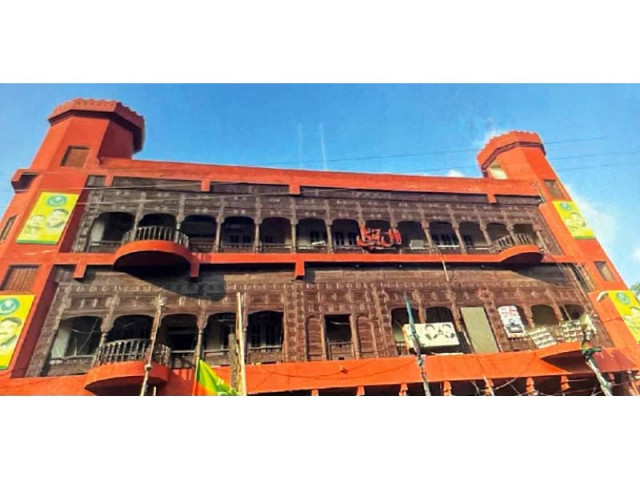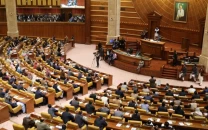Exploring historical facts about Pindi’s Lal Haveli
Timeless love story of a Hindu barrister and a Muslim dancer

Lal Haveli, the hub of political activities in the garrison city since 1985, is located in the 200-year-old commercial centre of Bohar Bazar opposite Moti Bazar, the women's shopping centre.
Formerly known as Sehgal Haveli, it was also called the abode of djinns and a haunted mansion for 30 years. The mansion, which was named after a Hindu Barrister Dhan Raj Sehgal, was his token of love for his beloved Muslim wife Budhan Bai, a former dancer.
The construction of Sehgal Haveli began in 1922 and was completed after five years in 1927. It is a magnificent masterpiece of Mughal, European and Kashmiri architecture, which is still maintaining its glory even after passing 95 years.
Sehgal was the eldest son of Kirpa Ram, the head of a very prosperous family of Jhelum. He earned his barrister-at-Law in London and on his return chose Rawalpindi instead of his ancestral city of Jhelum for practising law in 1919.
In the early 1920s, Barrister Sehgal had to travel from Rawalpindi to Sialkot to attend a traditional Hindu wedding in which a 20-year-old Muslim dancer, Budhan Bai, performed a classic dance.
Sehgal immediately fell in love with Bai and reached her home in Sialkot. He sought her hand in marriage with an attractive offer of taking her to the garrison city.
Beset by family problems, Bai, who was an orphan, accepted his offer to move to Rawalpindi with a bright future in her eyes. However, she said goodbye to dancing at the insistence of her husband.
After coming to Rawalpindi, Sehgal decided to build a magnificent mansion for Bai in Bohar Bazar. The construction of the magnificent three-storied Sehgal Haveli was started in April 1922.
A lot of money was spent to build the masterpiece. Brass, silver and special metals were used in the construction while Kashmiri motifs were painted on the walls. A special dance room was also built for Bai's love of dancing, where she used to dance in front of her husband.
A temple was built on one corner of the mansion and a mosque on the other, both facing each other. Barrister Sehgal would perform ‘pooja’ [prayer] in the temple while Bai would say her prayers in the mosque. Despite their unconditional love for each other, both of them did not change their religious beliefs.
For 20 years from 1927 to 1947, Barrister Dhan Raj Sehgal and Budhan Bai spent very loving days in this mansion. But at the end of 1946, when the Pakistan movement reached its peak, the houses of Hindus and Sikhs were burnt in Rawalpindi.
It was at this point that Sehgal decided to migrate to India with his family whereas Bai thought it better to stay. However, before parting their ways, Sehgal gifted the mansion and a very expensive 1938 model Austin car to Bai, leaving his goddess alone forever on the morning of one fine day in July 1947. Bai now lived with her younger brother in the mansion who earned a modest living which barely covered their kitchen expenses.
On one fateful night in the mid-70s, burglars broke into the Sehgal Haveli and stabbed Bai’s brother to death who had woken up from his sleep during the robbery.
This incident completely shattered Bai’s nerves. She was so disheartened that she quietly set off somewhere without telling anyone after attending the chehlum of her brother.
During her stay at the mansion, Bai used to smoke the Three Castles cigarettes sitting on the porch every day and outside the mansion, the children of the neighbourhood would play marbles whom Bai would give empty cigarette cases.
Later on, when the phase of handing over the derelict Hindu properties to the Evacuee Trust Property Board (ETPB) started, the case of Sehgal Haveli was also brought to the magistrate’s court.
When Bai reached the court, the compassionate old magistrate said to her, “If you state that Sehgal had become a Muslim or you have become a Hindu, this entire mansion can legally be transferred in your name. Otherwise, it will have to be handed over to the ETPB.”
At this Bai spoke the historic sentence: "We shared everything except religion.” After her final statement, the magistrate said, “This society is very cruel, it will bother you a lot later.”
Subsequently, he handed over the property to the ETPB and gave the two living rooms and the courtyard of the Haveli to Bai on humanitarian grounds.
In the mid-80s, a Kashmiri family bought this mansion for Rs218,000. Later, the family of the former interior minister bought this mansion from them for Rs550,000 and Rashid named it Lal Haveli in 1985.
Published in The Express Tribune, December 18th, 2022.



















COMMENTS
Comments are moderated and generally will be posted if they are on-topic and not abusive.
For more information, please see our Comments FAQ